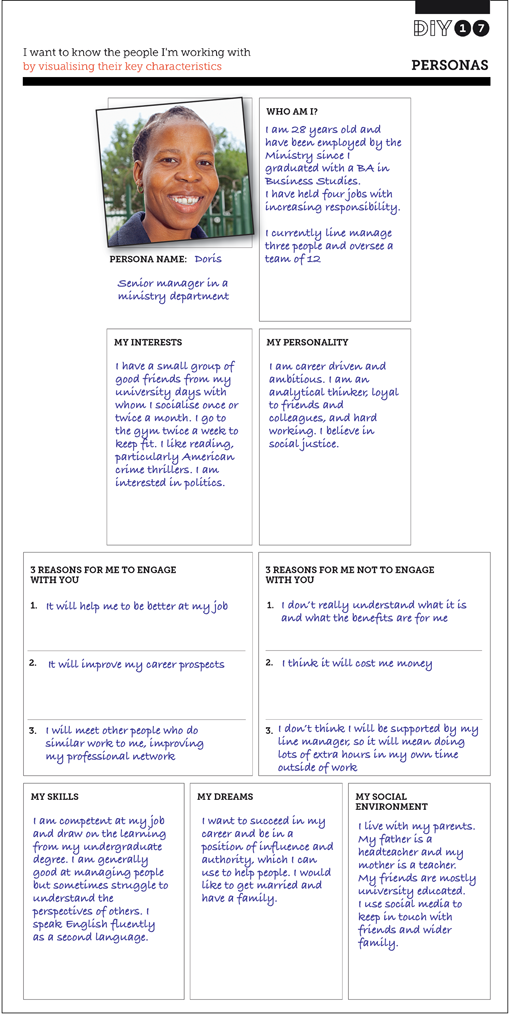4.1 Personas: a case study
The DIY Toolkit Personas template is a good basic framework for building personas. However in real life, you may have to expand or reduce the questions and or subsections, or change the template design to reflect the problem at hand.
The need for the personas, how many are required, and how detailed they should be will determine who will be involved in the process of creating them.
Case Study 1: Attracting students to the Postgraduate Leadership Development Programme
The Federal Ministry of Commerce in a developing country entered into a joint working contract with a leading university in the United States to help develop their next generation of senior managers and head of departments. This will be achieved through participation in the Postgraduate Leadership Development Programme, to be delivered in partnership with a local university.
Two years after signing the agreement, the programme has not been able to attract enough students to justify its existence. The Ministry is trying to understand why uptake is so low, and colleagues at the US university suggested using personas as a way to explore the needs and motivations of the target group.
Members of the project team from the Ministry interviewed three men and three women who would qualify for the programme, but have not yet applied. One of the men has complicated and demanding family commitments that are making it difficult for him to hold down his job, and would prohibit him from taking on any additional commitments. Among the other five, though, there are three common threads to their responses:
- they were only vaguely aware of the programme and did not think they qualified to participate
- they thought it would cost them money
- they didn’t believe their participation would be supported by their line managers, particularly with regard to allowing them time away from their desks to study.
These common points, along with other general information (including the restrictions on who qualifies for the programme), were sufficient to start building a persona. The draft persona, named Doris, is shown in Figure 1 below. (Please note that the team have used a stock photo to represent Doris.)
Activity 3
Look again at the case study above and Doris’s persona (Figure 1).
If you were a member of the project team, what would you advise the Ministry to do next? Make some notes in answer to this question in the text box below.
Discussion
The project team should now decide whether:
- a.this is sufficient information for them to start defining the problem and building a response
or
- b.they should use a survey to test whether these points really are common across a much wider selection of the target group.
If there are any other trends attributable to identifying features – such as gender, location, or duration of employment – they could also divide the persona into two or more. However, the project team must be careful not to stereotype (for example, by assuming that all the women will want to have children – and therefore need career breaks – just because Doris wants to). Depending on time constraints, they could start a cautious response, perhaps by changing the way they promote the programme and emphasising the qualifying criteria and that it is free. They could also plan some sort of engagement with potential line-managers of qualifying students. They could then organise a survey, to run at the same time, to check that they are taking the right course of action before they commit more resources to this solution.
4 Creating personas

